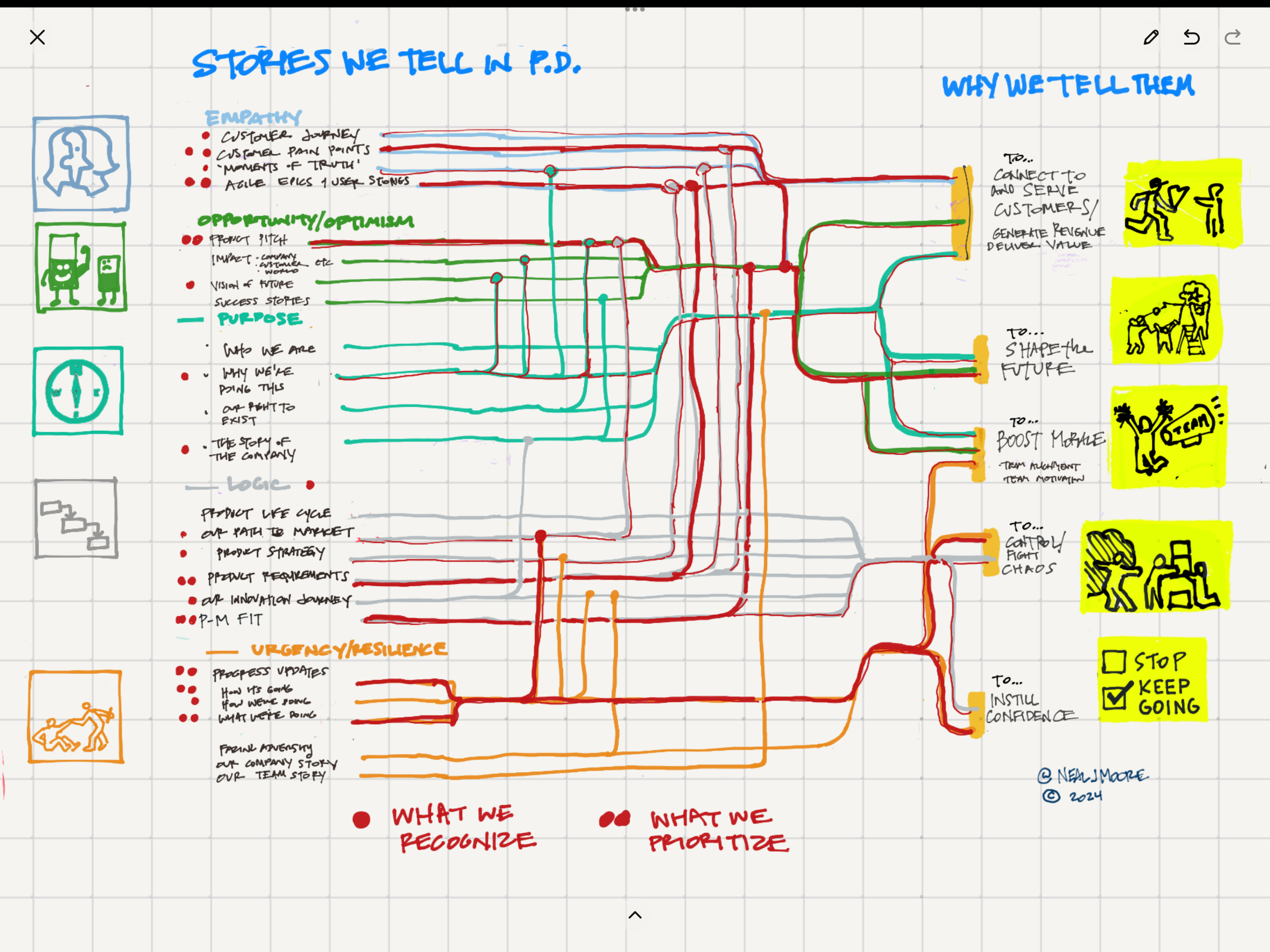Story + PD: Flavors, Goals, and Scenarios in One Map
Part of a series at the intersection of Storytelling and Product Development.
Product work has many opportunities to be enhanced with the right kind of stories.
How many of us have read our CEO’s annual letter, and the part that made you keep reading was not the “outstanding Q4 with 25% CAGR” but instead, the story they told of meeting a customer and learning the impact on their life. Or the story about how the company bounced back after a tough year for the industry. Or how they envision a new initiative that will transform the customer experience.
We’ve worked for different CEOs in different companies, yet some stories like these have a similar quality to them.
FLAVORS
I’ve noticed storytelling in PD has a few flavors, or intentions, or modes. (I like flavors for now.)
Logic
Empathy
Purpose
Resilience/Urgency
Optimism/Opportunity
GOALS of COMMUNICATION
Ultimately, many of the stories we recognize are meant to boost morale or rally the troops in some way. Or when they’re told well, like that CEO letter, that’s what they do.
Boosting team morale is one goal of storytelling in product development. Some types of stories
in PD are told for similar reasons:
To connect us to customers for better value creation
To shape our future
To boost our morale
To control chaos and unpredictability (eg, planning)
To instill confidence in our abilities (to deliver)
Some flavors of story are better for a desired goal. And some stories can hit more than one goal, like the customer story in my archetypal CEO letter. It takes work to find and to write that kind of story, and the bigger the stage, the more you should invest in that part of the process.
Because not everyone is into multicolored spaghetti, I’ll lay out what’s in the map here. There are scenarios in the Product workplace where internal communication happens. Sometimes a story is used. Sometimes it’s not, unless someone decides to do tell a story. All these scenarios can use Story deliberately to achieve a communication goal. It’s partly a matter of recognizing what you’re trying to do with your communication, and choosing the right flavor that fits the situation.
Diagram of stories by flavor, mapped to communication goals.
STORY CLUSTERS by FLAVOR
Empathy
Customer Journey
Customer pain points
Moments of Truth
Agile Epics and User Stories
Opportunity
Product Pitch
Impact
Vision of Future
Success Stories
Purpose
Who We Are
Why We’re Doing This
Our Right to Exist
The Story of Our Company
Logic
Product Life Cycle
Our Path to Market
Product Strategy
Product Requirements
Our Innovation Journey/Process
Product-Market Fit
Urgency/Resilience
Progress Updates
How It’s Going
How We’re Doing
Facing Adversity
Story of Our Team
Story Clusters by Goal
To Connect and Serve Customers
All Empathy Stories
All Opportunity Stories
All Purpose Stories
To Shape the Future
Purpose Stories
Opportunity Stories
To Boost Morale
Purpose Stories
Opportunity/Optimism Stories
Urgency/Resilience Stories
To Counter Chaos
Logic Stories
Urgency/Resilience Stories
To Instill Confidence
Urgency/Resilience Stories
Logic Stories
GREAT FLAVOR COMBOS
Add some of this to that to reach a communication goal
Pain Points + Product Requirements
Moments of Truth + Customer Journey
Moments of Truth + Vision Story
Purpose Stories + Logic (the head + heart combo)
Empathy stories + Opportunity stories
AWKWARD COMBOS/NOT RECOMMENDED
Some flavors don’t land on the right tastebuds for the occasion. This is the importance of understanding which Flavors are appropriate for which Goals. For example:
Empathy stories are not what leaders are looking for when missing deadlines.
A product-market fit story might seem like it creates the future. But will it move anyone?
A story of who we are can align the team, but stakeholders only care how it affects the deliverables.
SO WHAT?
I’ve touched upon several types of stories that are told in product development. I hope the scenarios and descriptions have resonated so far with everyone reading this far (thank you!). I also hope that you’ve begun to see how prevalent they are in our richly textured work lives, beyond the dozen or so I mentioned. Are there more? Think about it. When did you find a story or tell a story that moved a project forward or changed a colleague’s mood or a stakeholder’s mind?
There are so many contexts beyond what gets the attention. There are a few types of stories we tend to prioritize in PD, but imagine how much more effective and meaningful all of our work could be when we recognize, “hey, this could use some storytelling” or “we need to find the story in this situation” or “this story is not one we want to be living, let’s rewrite it.”
